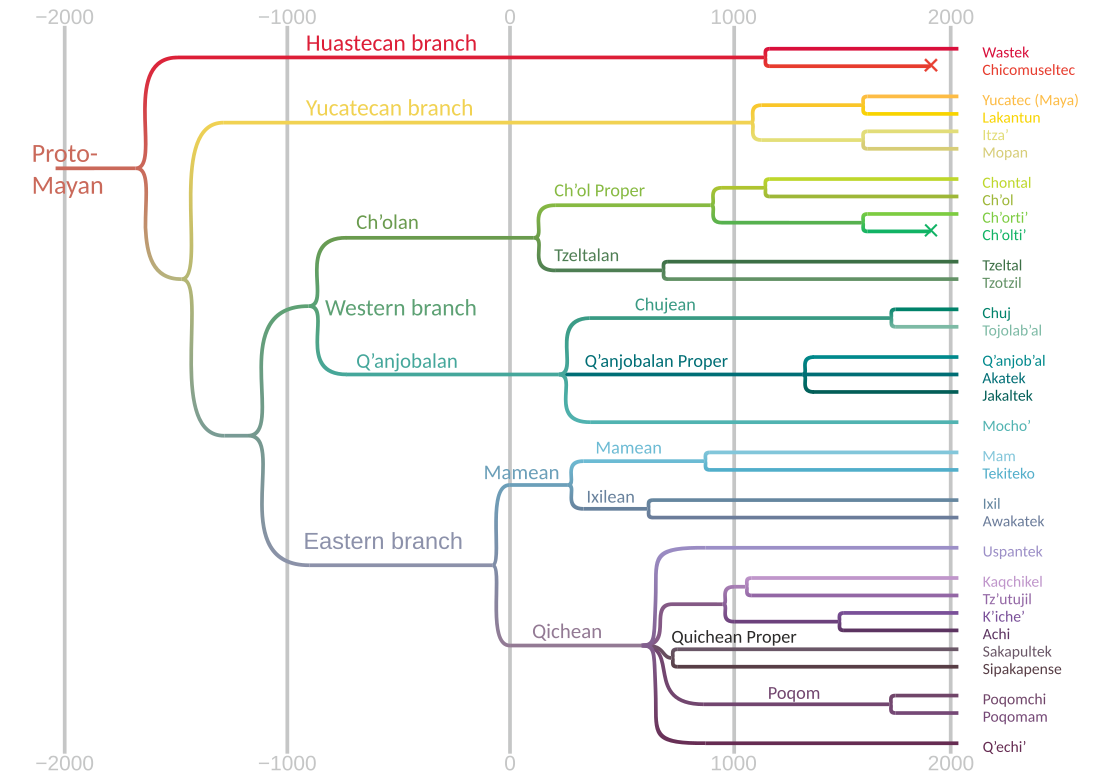Ixil language
Mayan language of Mexico and Guatemala From Wikipedia, the free encyclopedia
Ixil (Ixhil) is a Mayan language spoken in Mexico and Guatemala.[2] It is the primary language of the Ixil people, which mainly comprises the three towns of San Juan Cotzal, Santa María Nebaj, and San Gaspar Chajul in the Guatemalan highlands and numerous towns in the states of Campeche and Quintana Roo in southeast México.[3] There is also an Ixil speaking migrant population in Guatemala City, Mexico City and the United States. Although there are slight differences in vocabulary in the dialects spoken by people in the three main Guatemalan Ixil towns, they are all mutually intelligible and should be considered dialects of a single language. According to historical linguistic studies Ixil emerged as a separate language sometime around the year 500AD.
| Ixil | |
|---|---|
| Ixhil | |
| Pronunciation | [iʂil] |
| Native to | Guatemala, Mexico |
| Region | Quiché Department Campeche, Quintana Roo |
| Ethnicity | 133,329 Ixil (2019 census) |
Native speakers | 120,000 (2019 census)[1] |
Mayan
| |
| Dialects |
|
| Latin | |
| Official status | |
Recognised minority language in | |
| Regulated by | Instituto Nacional de Lenguas Indígenas Academia de Lenguas Mayas de Guatemala |
| Language codes | |
| ISO 639-3 | ixl |
| Glottolog | ixil1251 |
| ELP | Ixil |

Distribution
Ixil language is spoken in Mexico in some municipalities of the states of Campeche and Quintana Roo. In the state of Campeche is spoken in the communities of Los Laureles and Quetzal-Edzná from the Campeche municipality and in Maya Tecún in Champotón municipality, while in Quintana Roo is spoken in the towns of Maya Balam and Kuchumatán, Bacalar municipality.
In Guatemala, the municipalities where Ixil is spoken the most are San Gaspar Chajul, San Juan Cotzal and Santa María Nebaj, Quiché department.
Phonology
| Labial | Alveolar | Post- alveolar |
Retroflex | Palatal | Velar | Uvular | Glottal | |||
|---|---|---|---|---|---|---|---|---|---|---|
| Nasal | m ⟨m⟩ | n ⟨n⟩ | ||||||||
| Plosive/ Affricate |
plain | p ⟨p⟩ | t ⟨t⟩ | t͡s ⟨tz⟩ | t͡ɕ ⟨ch⟩ | ʈ͡ʂ ⟨tx⟩ | k ⟨k⟩ | q ⟨q⟩ | ʔ ⟨'⟩ | |
| glottalized | ɓ ⟨bʼ⟩ | tʼ ⟨tʼ⟩ | t͡sʼ ⟨tzʼ⟩ | t͡ɕʼ ⟨chʼ⟩ | ʈ͡ʂʼ ⟨txʼ⟩ | kʼ ⟨kʼ⟩ | qʼ ⟨qʼ⟩ | |||
| Fricative | β ~ v ⟨v⟩ | s ⟨s⟩ | ɕ ⟨xh⟩ | ʂ ⟨x⟩ | χ ⟨j⟩ | |||||
| Flap | ɾ ⟨r⟩ | |||||||||
| Approximant | (w ⟨v⟩) | l ⟨l⟩ | j ⟨y⟩ | |||||||
Sample Words
Source:[6]
| One | Wa'l |
| Two | Ka'wa'l |
| Three | Oxhwal |
| Man | Winaq |
| Woman | Ixoq |
| Dog | Tx'i' |
| Sun | Q'ij |
| Moon | Ich' |
| Water | Ja |
| Deer | Che |
| Jaguar | B'alam |
| Monkey | K'oy |
| Rabbit | Umul |
| Mouse | Ch'o |
| Bird | Tz'ikyin |
| Fish | Txay |
| Bee | Uskab |
| Black | Q'eq |
| White | Saq |
| Red | Kaq |
| Yellow | Q'an |
| Green | Cha'x |
| Blue | Cha'x |
Grammar
This section needs expansion. You can help by adding to it. (December 2008) |
Ixil pronominals are discerned between ergative ones and absolutive ones.[7] A notable feature of the language's grammar is its ambiguity in discerning reflexive from reciprocal pronouns.[8]
See also
Notes
Bibliography
External links
Wikiwand - on
Seamless Wikipedia browsing. On steroids.
